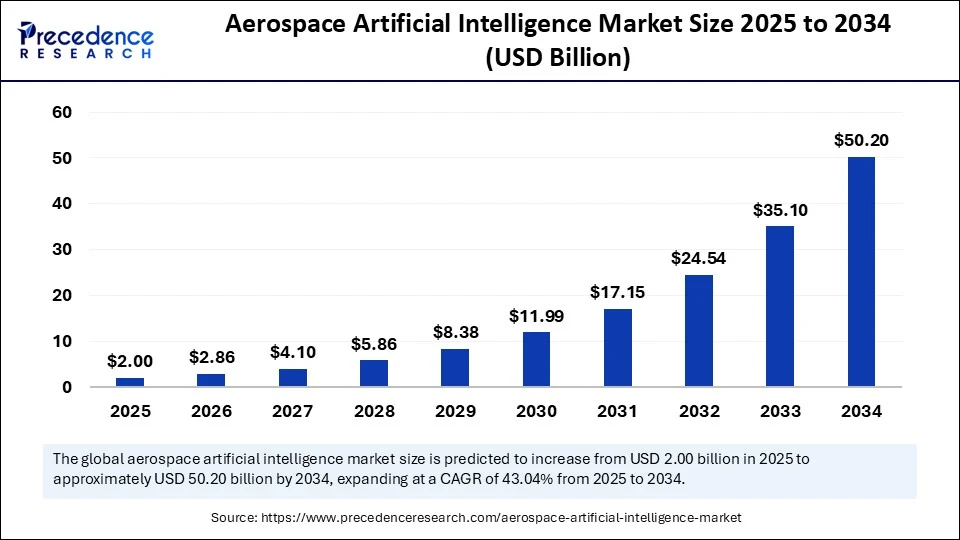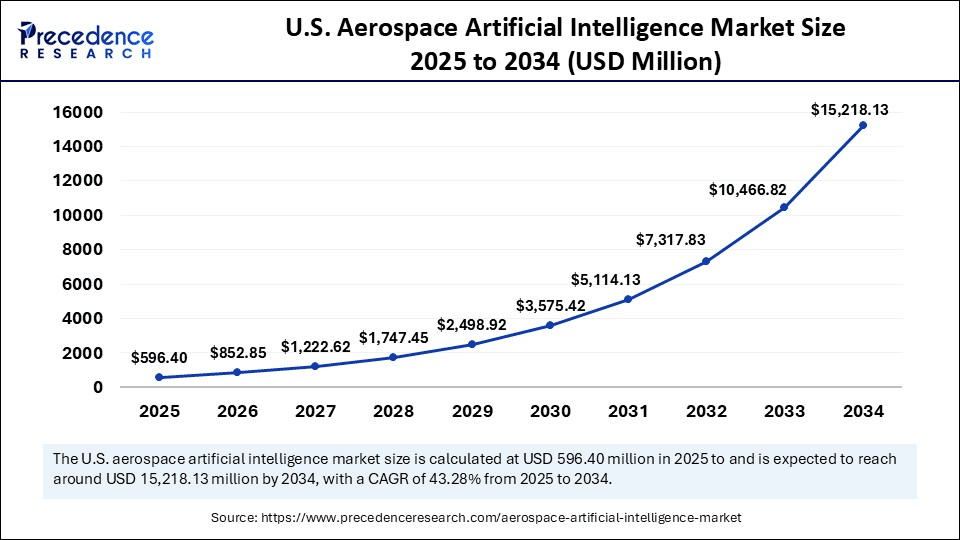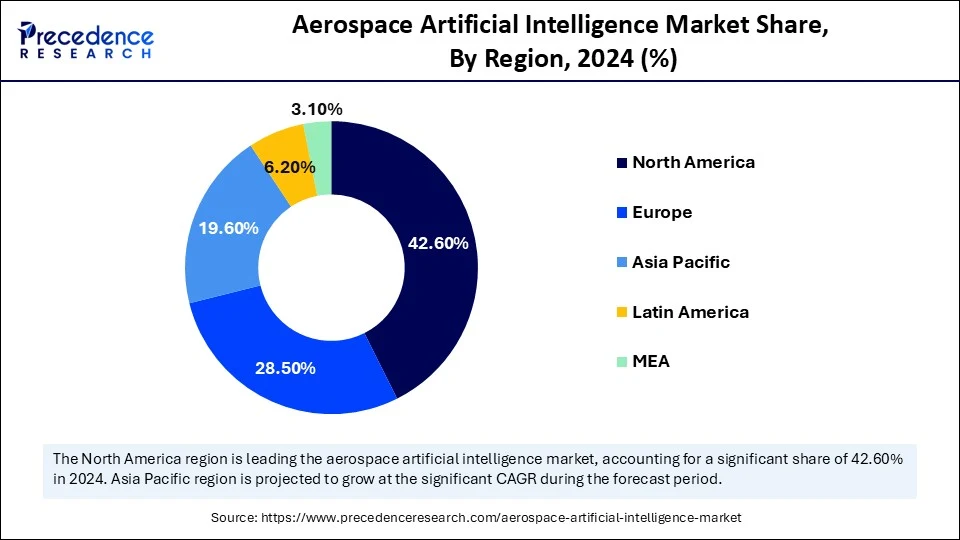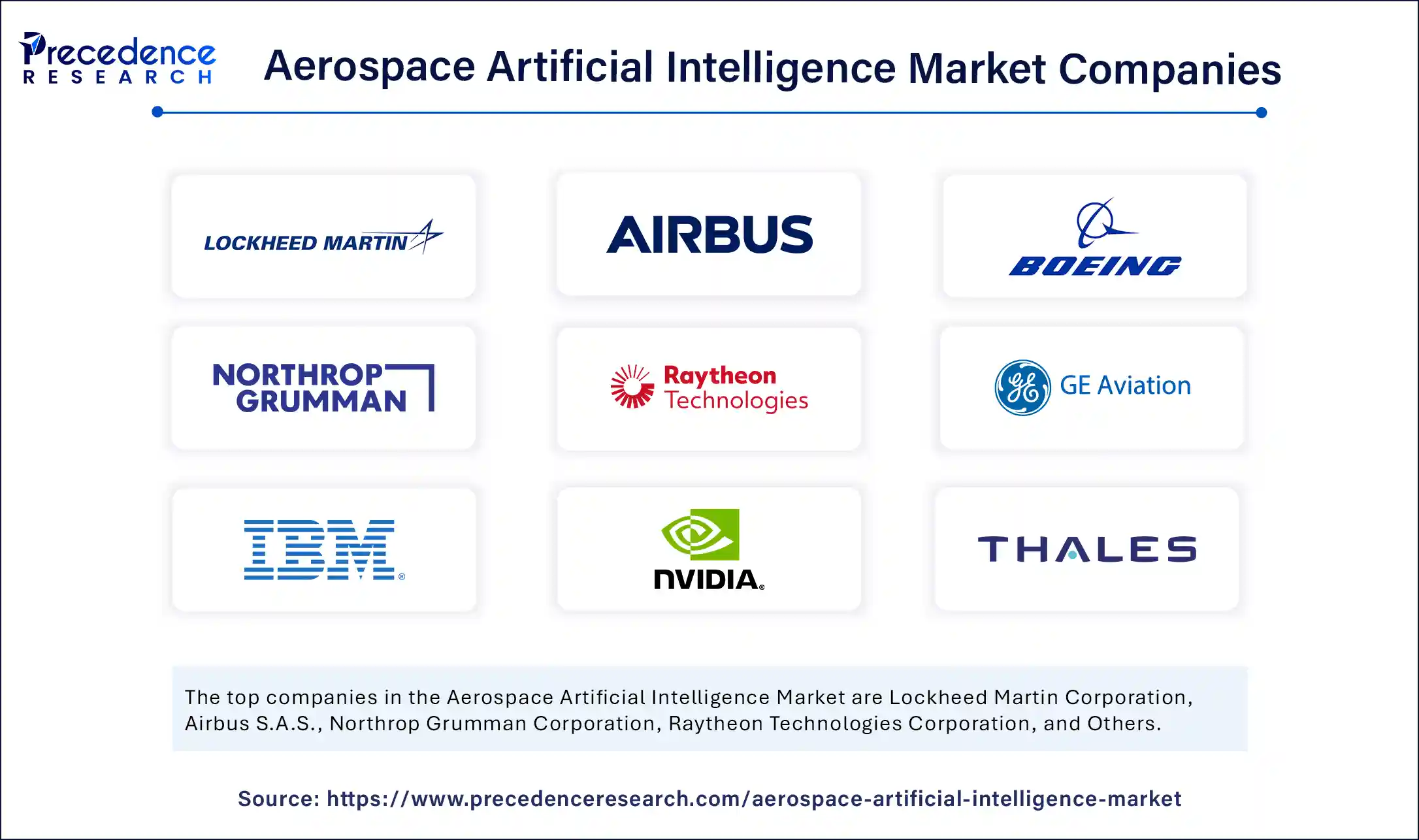List of Contents
Aerospace Artificial intelligence Market Size and Forecast 2025 to 2034
The global aerospace artificial intelligence market size was estimated at USD 1.40 billion in 2024 and is predicted to increase from USD 2.00 billion in 2025 to approximately USD 50.20 billion by 2034, expanding at a CAGR of 43.04% from 2025 to 2034. The market is expanding due to advancement in machine learning, data analytics and innovative AI applications in aerospace sector to strengthen national security along with strategic collaborations, moves, and governments initiatives for AI integration in the aerospace sector.

Aerospace Artificial intelligence Market Key Takeaways
- In terms of revenue, the global aerospace artificial intelligence market was valued at USD 1.40 billion in 2024.
- It is projected to reach USD 50.20 billion by 2034.
- The market is expected to grow at a CAGR of 43.04% from 2025 to 2034.
- North America dominated the aerospace artificial intelligence market with the largest market share of 42.6% in 2024.
- Asia Pacific is expected to witness the fastest CAGR during the forecast period.
- By offering, the software segment held the biggest market share of 38.5% in 2024.
- By offering, the services segment is expected to witness the fastest growth during the foreseeable period.
- By technology, the machine learning (deep learning) segment captured the highest market share of 41.2% in 2024.
- By technology, the computer vision segment is expected to witness the fastest CAGR during the projection period.
- By application, the manufacturing segment dominated the market, under which the predictive maintenance segment held the largest market share of 26.8% in 2024.
- By application, the autonomous systems segment is expected to witness the fastest growth between 2025 and 2034.
- By platform, the commercial aircraft segment contributed the major market share of 33.7% in 2024.
- By platform, the unmanned aerial vehicles segment is expected to witness the fastest CAGR during the foreseeable period of 2025-2034.
- By deployment, the on-premises segment held the largest market share of 52.4% in 2024.
- By deployment, the edge segment is expected to witness the fastest CAGR during the foreseeable period.
- By end-user, the OEMs segment generated the major market share of 35.9% in 2024.
- By end-user, the airlines segment is expected to witness the fastest CAGR during the foreseeable period.
U.S. Aerospace Artificial intelligence Market Size and Growth 2025 to 2034
The U.S. aerospace artificial intelligence market size was exhibited at USD 417.48 million in 2024 and is projected to be worth around USD 15,218.13 million by 2034, growing at a CAGR of 43.28% from 2025 to 2034.

What Made North America the Dominant Region in the Aerospace Artificial Intelligence Market in 2024?
North America dominated the market with the largest market share of 42.6% in 2024. This is mainly due to its substantial investment in research & development of AI and aerospace technologies. The region also boasts a well-established aerospace sector. The presence of major aerospace companies that are highly dedicated to various missions bolstered the growth of the market. The region is highly benefited due to strong government funding for national security and integration of AI technologies, and collaboration between private and government aerospace companies that share infrastructure and advanced AI technologies that can be utilized for space exploration and aerospace applications.
On a country level, the U.S. is a frontier in the market, owing to its significant investment in the aerospace sector and early adoption of AI. Increasing research & development in AI and initiatives backed by the government further strengthen the country's position in the market. Moreover, the rising development of sophisticated aircraft contributes to market growth in the U.S.

What Makes Asia Pacific the Fastest-Growing Region in the Aerospace Artificial Intelligence Market?
Asia Pacific is expected to experience the fastest growth during the foreseeable period of 2025-2034. This is mainly due to the rising investments in the aerospace sector. The rising demand for novel military aircraft and increasing focus on AI integration in aircraft for precise surveillance capability and threat detection support market growth. The increasing number of AI startups with government funding and growing collaboration between tech players in the region further offer opportunities in the market.
On a country level, China is a significant player in the Asia-Pacific aerospace artificial intelligence market due to its strategic focus on national security, technological evolution, and increasing budget for the deployment of AI models into the aerospace sector. China's AI firms are closing gaps between highly efficient and well-established AI models deployed by the leading players in the U.S., showcasing its capability to win the race of artificial general intelligence. On the other hand, emerging countries like India and Japan are also heavily investing in AI research and government initiatives to support the growth of the aircraft market.
Market Overview
The aerospace artificial intelligence (AI) market encompasses the integration of AI technologies into various applications across the aerospace sector, including civil aviation, Défense, and space exploration. AI is applied for predictive maintenance, flight operation optimization, air traffic control, manufacturing automation, surveillance, satellite navigation, and more. By enabling data-driven decision-making, real-time systems optimization, autonomous functionalities, and enhanced safety, AI significantly transforms aerospace engineering, operations, and mission effectiveness.
Major Applications of AI in the Aerospace Sector
| Area | Scope |
| Design and engineering | AI algorithms with ML models can optimize aircraft designs, simulations, and support predictive maintenance. |
| Maintenance, repair and overhaul | AI can minimize downtime and operational costs by predicting faults prior, and schedules repairs. |
| Management of air traffic | AI-based systems can suggest optional routes, optimize flight paths to ensure safety, efficiency, and improve situational awareness of pilots. |
| Space exploration | Space exploration found extensive applications of AI like mission planning, huge data handling/analysis, and autonomous systems. |
| Consumer services | AI-based chatbots can improve personalization by offering instant solutions for consumers queries, which enhances the overall travelling experience. |
What are the Key Trends in the Aerospace Artificial Intelligence Market?
- Integration of AI into Flight Operations: A significant key trend is the rising integration of AI models, such as machine learning, NLP processing, and computer vision, in flight operations, which increases various aspects of the aerospace sector and improves precise operations. Improvisation in pilot training is achievable with the integration of computer vision and voice recognition. Moreover, predictive maintenance and fuel consumption optimization are possible through AI models, which further reduce the overall costs of manufacturing and operations in aerospace.
- Rising Need for Safety and Efficiency: Artificial intelligence has gone beyond only manufacturing and maintenance in aerospace by offering crucial aspect of it, which is safety. AI possess ability to analyse huge datasets from various sensors and systems of aerospace sector and determine specific patterns that can be useful for efficiency and safety. AI can act as a supervisor for time series data analysis for anomaly detection and predictive maintenance for aircraft's parts.
- Growing Need to Optimize Airport Operations: Another significant trend is the application of AI in airport operations, which includes virtual assistants, surveillance, and big data analytics to enhance consumers' experience and operational efficiency. Real-time data processing and analysis are possible with the help of cloud-based applications and networking. Effective implementation and maintenance of AI systems can be ensured by specialized technicians who have technical skills.
Market Scope
| Report Coverage | Details |
| Market Size by 2034 | USD 50.20 Billion |
| Market Size in 2025 | USD 2.00 Billion |
| Market Size in 2024 | USD 1.40 Billion |
| Market Growth Rate from 2025 to 2034 | CAGR of 43.04% |
| Dominating Region | North America |
| Fastest Growing Region | Asia Pacific |
| Base Year | 2024 |
| Forecast Period | 2025 to 2034 |
| Segments Covered | Offering, Technology, Application, Platform, Deployment, End User, and Region |
| Regions Covered | North America, Europe, Asia-Pacific, Latin America, and Middle East & Africa |
Market Dynamics
Drivers
Growing Rate of Air Traffic Worldwide
The increasing rate of air traffic globally is a significant driving factor of the aerospace artificial intelligence market. AI is offering enhanced operational efficiency and improving safety standards in response to evolving requirements and demand from the aerospace indusry. AI models are being deployed for prototyping and implementing advanced solutions for flight operations and enhanced consumer services. AI technologies have become essential part of the aerospace sector to manage and optimize air traffic flow, minimize congetion in air routes and adherence to regulatory compliances for safety. Airport operations can also seamlessly be performed by the integration of AI models for surveillance, big data analytics and virtual assistant reducing need for human interaction every time to handle masses and crowdy areas.
Restraint
Potential Cyberattacks
One of the significant barriers that the aerospace artificial intelligence market faces is a higher possibility of cyberattacks due to the vulnerability of crucial datasets from the aerospace field as it integrates with artificial intelligence. Regulatory compliance for the ethical use of AI is still in a pipeline and hasn't yet been confirmed by any authorities, as this technology is evolving in nature and exposed to various possibilities, which is baffling for many tech leaders and the government to take strict action against it. As AI platforms store sensitive information, they are prime targets for attackers. Growing concerns over unauthorized access to confidential data about the aerospace sector further restrict the growth of the market.
Opportunity
Easier Cockpit Interaction by NLP Fusion
The aerospace sector is leveraging the benefits of artificial intelligence in many of its domains or sub-sectors by incorporating technologies like computer vision, machine learning, and natural language processing (NLP). Among these, the integration of NLP into the flight's cockpit is one of the emerging technologies in the market, which is significantly changing the interactive mode between pilots and the stationary communication system dedicated to airplanes' route, landing, and resolving on-air queries to guide pilots precisely, which ensures safety and integrity. This has become easier as NLP allows communication in a simple/natural human language that can be processed by an NLP system of AI and transmitted to the desired destination with similar modulation, mitigating the need for coded language. This will improve human-machine interaction while serving seamless operations for the aerospace sector.
Offerings Insights
How Does the software segment dominate the aerospace artificial intelligence market in 2024?
The software segment dominated the market, holding the largest share of 38.5% in 2024. This is mainly due to the crucial role of AI solutions in the development of autonomous systems of spacecraft, such as UAVs and drones. To enable navigation, barrier detection, and real-time data analysis for decision-making, AI software is an essential tool that enables the system to work autonomously with minimum human intervention. AI software systems can optimize flight control systems with data analysis gathered from various sensors, which allows adjustment of flight parameters in real-time, further enhancing safety and improving fuel efficiency of the spacecraft.
The services segment is expected to witness the fastest growth during the forecast period. The growth of the segment is attributed to the growing complexity of the integration of AI systems. To successfully implement AI systems in the existing infrastructure, the need for expertise support is rising. Moreover, the increasing demand for training and support services contributes to segmental growth.
Technology Insights
Why Did the Machine Learning Segment Dominate the Aerospace Artificial Intelligence Market in 2024?
The machine learning (deep learning) segment held the largest market share of 41.2% in 2024. This is mainly due to the crucial role played by machine learning and deep learning technologies in the aerospace sector. They offer intricate insights by analyzing a huge number of datasets in real-time and provide a quick action plan as well. Various applications, such as threat detection systems, predictive maintenance, and automated decision-making systems, can be improved by machine learning models without human interference. This model can also learn from new datasets and offer continuous improvement. This ability of machine learning makes it an impeccable application of AI in the aerospace sector.
The computer vision segment is expected to grow at the fastest CAGR during the projection period. Computer vision offers the ability to deeply probe into images and videos and enable processing of visual data gathered from cameras, drones, and various satellites in real time. Thus, computer vision is extensively beneficial and utilized in applications like facial recognition, autonomous vehicle navigation, and obstacle detection for better accuracy and efficiency.
Application Insights
What Made Predictive Maintenance the Dominant Segment in the Aerospace Artificial Intelligence Market in 2024?
The manufacturing segment led the market, under which the predictive maintenance sub-segment held the largest market share of 26.8% in 2024. This is mainly due to its high adoption in the aerospace sector, driven by its ability to offer enhanced safety features, unprecedented efficiency, and provide real-time analysis. Unlike a traditional maintenance schedule, which is highly expensive, predictive maintenance offers precision problem solving with early fault detection and reduces operational cost as well as avoids emergency repairs.
The autonomous system segment is expected to expand at the fastest CAGR during the foreseeable period. The growth of the segment is attributed to the rising demand for autonomous aircraft, flight management systems with AI integration, and the increased use of UAVs and robots for various aerospace applications. The rising production of UAVs further supports segmental growth.
Platform Insights
Why Did the Commercial Aircraft Segment Lead the Aerospace Artificial Intelligence Marke?
The commercial aircraft segment held the largest market share of 33.7% in 2024, as commercial platforms primarily operate at a fixed margin and seek various ways to improve efficiency, which lowers fuel usage to optimize flight operations. AI algorithms offer precise real-time data analysis, fulfill demand for high security with predictive maintenance, and assist pilots to manage complex flight operations, which further mitigates the chances of fatal emergencies/accidents.
The unmanned aerial vehicles (UAVs) segment is expected to witness the fastest growth during the foreseeable period of 2025-2034. The segment is witnessing rapid growth due to increasing demand for autonomous performance, expanding capabilities of UAVs, and rising adoption of UAVs for military operations to reduce human dependency. The rising development of AI-powered drones for military purposes further contributes to the growth of the segment.
Deployment Insights
What Made On-Premises the Dominant Segment in the Aerospace Artificial Intelligence Market?
The on-premises segment dominated the market with the largest market share of 52.4% in 2024. The dominance of the segment is attributed to the increased preferences for secure and controlled space where confidential data and applications can be easily managed without a fear of unauthorized access. On-premises deployment is ideal and preferred by many organizations that are planning for critical missions and looking for high security measures while in adherence to strict regulations. Moreover, on-premises deployment offers greater control over hardware, software, and data management within a secure, highly restricted environment, making it a reliable deployment method.
The edge segment is expected to register the fastest CAGR in the upcoming period. The segment growth is attributed to the rising mission-critical programs, which require instantaneous responses and quick decision-making for successful operations. Processing data from the nearest possible source with the help of edge AI deployment reduces possible delays and offers nearly no latency.
End-User Insights
How Does the OEMs Segment Dominate the Aerospace Artificial Intelligence Market in 2024?
The OEMs segment dominated the market while holding the largest market share of 35.9% in 2024. OEMs offer highly advanced avionics systems with AI integration, which enhance aircraft capabilities, including navigation systems, pilot assistant tools, and flight control systems backed with AI. The growing demand for new aircraft for commercial purposes and business jets is further fueling the segment's growth. Strict safety regulations further boost the adoption of AI tools among OEMs.
The airlines segment is expected to witness the fastest growth during the foreseeable period of 2025-2034. The segment is expanding due to factors like increased need for operational efficiency and cost reduction. The rising demand for fuel efficiency, along with government support worldwide, is encouraging the integration of AI in the airlines due to its benefits and enhanced security features.
Aerospace Artificial intelligence Market Companies

- Lockheed Martin Corporation
- Airbus S.A.S.
- Boeing Company
- Northrop Grumman Corporation
- Raytheon Technologies Corporation
- General Electric Aviation
- IBM Corporation
- NVIDIA Corporation
- Thales Group
- BAE Systems
- Honeywell Aerospace
- Leidos Holdings, Inc.
- Palantir Technologies
- SITA
- Indra Sistemas
- SparkCognition
- Collins Aerospace
- SAS Institute Inc.
- Amazon Web Services (AWS)
- Intel Corporation
Recent Developments
- In March 2025, Lockheed Martin collaborated with Google Cloud to integrate Lockheed Martin's AI factory ecosystem with Google's advanced generative artificial intelligence, which will be beneficial for the national security and aerospace sector with AI-backed capabilities. (Source:https://www.lockheedmartin.com)
- In May 2025, a leading player in the aviation industry, Boeing, announced its integration of artificial intelligence to transform its fleet management with the help of predictive maintenance and digital twin technology. (Source: https://www.dubaiairshow.aero)
Segments Covered in the Report
By Offering
- Hardware
- Processors (GPU, CPU, ASIC, FPGA)
- Memory
- Sensors
- Others
- Software
- AI Platforms
- AI Solutions
- Middleware
- Others
- Services
- Deployment & Integration
- Training & Support
- Consulting
By Technology
- Machine Learning
- Supervised Learning
- Unsupervised Learning
- Reinforcement Learning
- Deep Learning
- Natural Language Processing (NLP)
- Computer Vision
- Context Awareness
- Others
By Application
- Flight Operations
- Pilot Assistance Systems
- Flight Planning & Navigation
- Manufacturing
- Predictive Maintenance
- Quality Inspection
- Robotics in Assembly
- Training & Simulation
- Flight Simulators
- Maintenance Crew Training
- Air Traffic Management
- Real-Time Route Optimization
- Collision Avoidance
- Surveillance & Reconnaissance
- Satellite Imagery Analysis
- Border Monitoring
- Autonomous Systems
- Drones / UAVs
- Unmanned Space Vehicles
- Cybersecurity
- Others
By Platform
- Military Aircraft
- Commercial Aircraft
- Business & General Aviation
- Unmanned Aerial Vehicles (UAVs)
- Satellites
- Spacecraft
- Helicopters
- Others
By Deployment
- On-premises
- Cloud-based
- Edge
By End User
- OEMs (Original Equipment Manufacturers)
- Airlines
- Space Agencies
- Defense Organizations
- Maintenance, Repair, and Overhaul (MRO)
- Airport Authorities
- Others
By Region
- North America
- Europe
- Asia Pacific
- Latin America
- Middle East & Africa
For inquiries regarding discounts, bulk purchases, or customization requests, please contact us at sales@precedenceresearch.com
Frequently Asked Questions
Ask For Sample
No cookie-cutter, only authentic analysis – take the 1st step to become a Precedence Research client